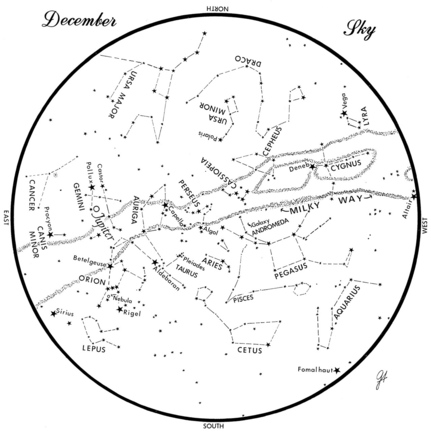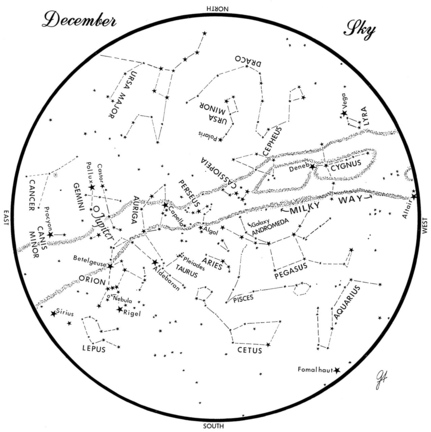December always marks the beginning of winter for us in the northern hemisphere. This year the winter solstice will happen at 12:11 p.m. on the 21st. That is the lowest point that the sun will reach for the year. The word solstice means “sun stands still,” which is what it will appear to do for a few days before it begins once again to rise higher in our sky as our days will get longer again. Track and mark the sun against a foreground of trees or a landmark to prove this for yourself.
There will be many exciting highlights upcoming. The most exciting and unpredictable one will be Comet ISON after it swings around the sun in late November. If it survives its close encounter with the sun, it could get quite bright in our morning sky even if it breaks apart.
Comet ISON will be visible low in the east-southeastern sky half an hour before sunrise to the left of Saturn and Mercury. Watch as the comet then gets higher in the sky, but it will also start to fade as it gets farther away.
A slender waning crescent moon will appear directly between Saturn and Mercury half an hour before sunrise on the morning of Sunday, Dec. 1. The comet will be about 10 degrees to the left of this luminous trio.
The Geminid meteor shower will peak on Saturday morning the 14th. You could normally expect more than 60 meteors per hour from this predictable shower, but this year the moon will be just three days before full, washing out many meteors.
This is a more mysterious meteor shower than most because it is caused by an asteroid named 3200 Phaethon instead of a comet. This asteroid, just discovered in 1983, may be a dead comet nucleus, but it is still shedding material. These meteors will leave brighter streaks because the material is denser and will burn up in our upper atmosphere at about 80,000 mph, which is much slower than other showers like the Perseids, Orionids and Leonids.
So find a dark sky site with an open view and bundle up and enjoy one of nature’s great spectacles that will put you more in tune with Earth, our life-giving atmosphere and the sky.
Brilliant Venus will reach its maximum magnitude for the year in December. You can see it best about one hour after sunset low in the southwestern sky. Through a telescope you will see that it is slowly getting larger and thinner as it gets closer to Earth even as it gets less illuminated. Watch as a slender waxing crescent moon passes above it on the evening of the fifth.
Jupiter now rises shortly after sunset in the constellation of Gemini, which is part of the famous hexagon that becomes quite prominent in the eastern sky as winter approaches. The king of the planets will reach opposition early next year, when it will be at its best and brightest for the whole year. Watch the full moon pass near Jupiter on the evening of the 17th and 18th.
Mars is slowly starting to get brighter and closer again, now rising a little after midnight.
Mercury will be in our morning sky for the first half of December, and Saturn will be visible in the morning sky all month, rising around 5 a.m. Comet ISON, changing position a little each morning, will create an interesting celestial dance with these two planets.
A Minotaur rocket was recently launched from Virginia, carrying a record number of 29 satellites into orbit. Twenty-eight of them were small cubesats, one of which was designed by high school students. Another one was only a little bigger, the size of a loaf of bread, but it has a huge mission. Named Firefly, it will study lightning to see if it can produce gamma rays. .
A Minotaur 5 rocket was launched from the same site on Sept. 7. It carried just one satellite – LADEE, which stands for Lunar Atmospheric and Dust Environment Explorer. One of the most exciting projects it is working on is using laser beams for communication, which is building the groundwork for an interplanetary internet.
Last month’s rare hybrid solar eclipse was an extremely dramatic event, even though it was cloudy in this area for the partial phase that we could have seen. The live feed from northern Kenya set up on the eastern shore of Lake Turkana, which used to be the source of the Nile River.
This was a very symbolic and fitting place from which to watch this total solar eclipse, which always offers us a very brief glimpse into the great beauty and power of our life-giving sun. This place embodies the ancient origins of humans on our planet and now offers new energy for Africa since the largest wind project will soon be built on this lake. Earth’s great tectonic forces are splitting Africa apart along this location, even as the sun’s much greater forces are always in contact with Earth through the solar wind.
Watching this solar eclipse was a great lesson demonstrating basic laws of geometry, trigonometry, physics and math, and giving us a much better sense of the true nature of our 8,000-mile-wide Earth as it hurtles through the galaxy at enormous speeds, dragged along with our family of planets by the sun in a beautiful helical spiral path. The next one in this country will happen on Aug. 21, 2017.
Dec. 1: The slender waning crescent moon will be near Saturn, Mercury and Comet ISON this morning.
Dec. 2: New moon is at 7:22 p.m.
Dec. 5: Brilliant Venus will shine just to the left of the waxing crescent moon this evening.
Dec. 9: Jupiter will be very close to a bright star in Gemini named Delta Geminorum this evening. first quarter moon is at 10:12 a.m.
Dec. 13-14: The Geminid meteor shower this night into the morning of the 14th.
Dec. 15: Aldebaran in Taurus shines a few degrees to the lower right of the moon tonight.
Dec. 17: Full moon is at 4:28 a.m. This is also known as the Cold Moon or the Long-Night Moon.
Dec. 18: Jupiter will be near the just-past-full moon tonight.
Dec. 21: The winter solstice is at 12:11 p.m. EST.
Dec. 25: Sir Isaac Newton was born on this day in 1642.
Dec. 26: The waning crescent moon passes near Mars this morning and Spica in Virgo the mext morning.
Dec. 27-30: Mars shines within one degree of the double star in Virgo named Porrima over these mornings.
Bernie Reim of Wells is co-director of the Astronomical Society of Northern New England.
Send questions/comments to the editors.




Success. Please wait for the page to reload. If the page does not reload within 5 seconds, please refresh the page.
Enter your email and password to access comments.
Hi, to comment on stories you must . This profile is in addition to your subscription and website login.
Already have a commenting profile? .
Invalid username/password.
Please check your email to confirm and complete your registration.
Only subscribers are eligible to post comments. Please subscribe or login first for digital access. Here’s why.
Use the form below to reset your password. When you've submitted your account email, we will send an email with a reset code.